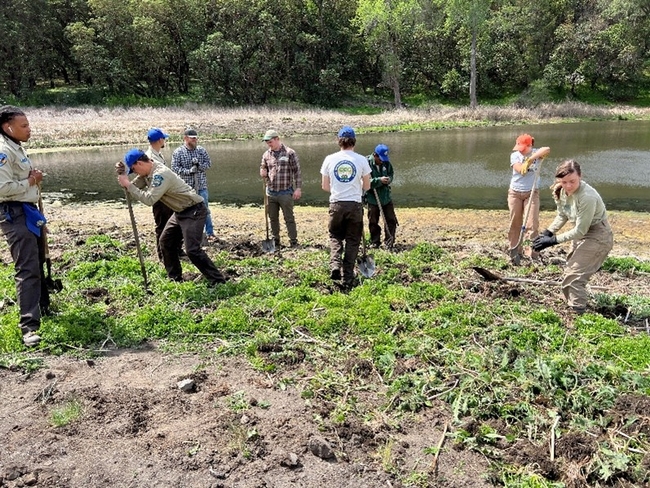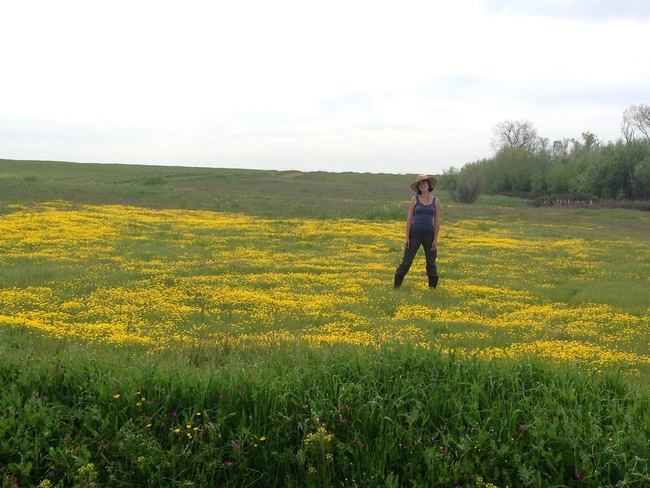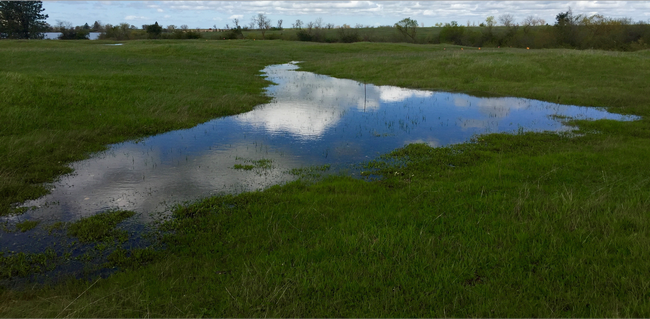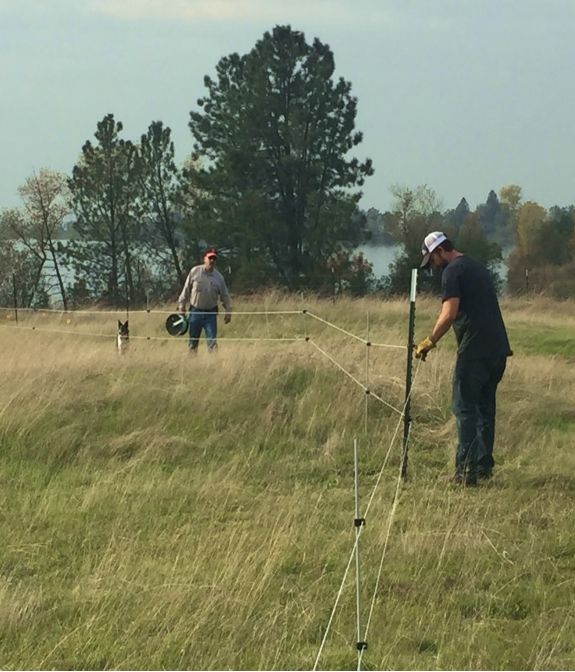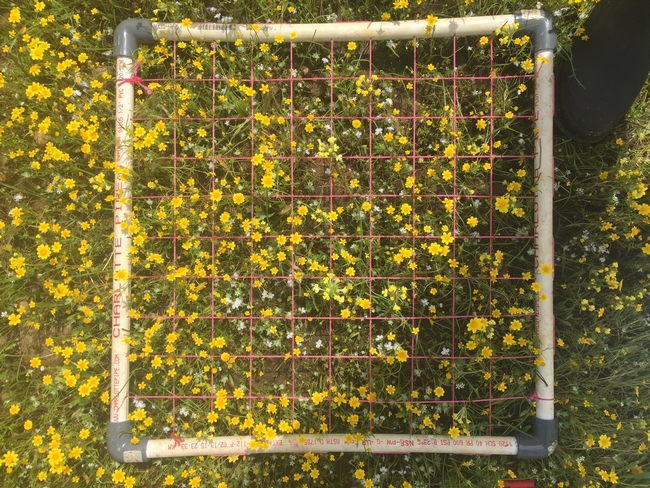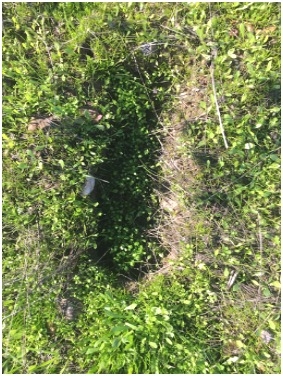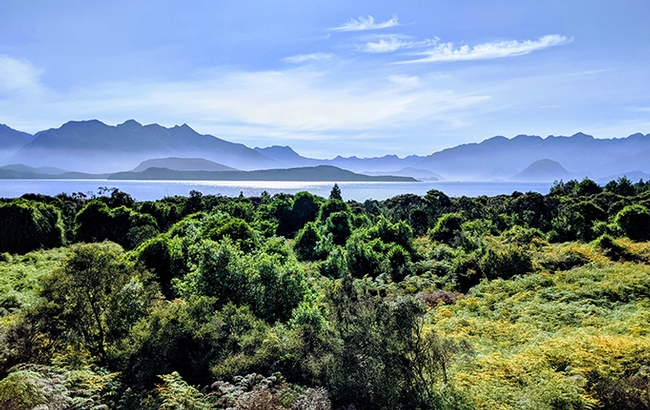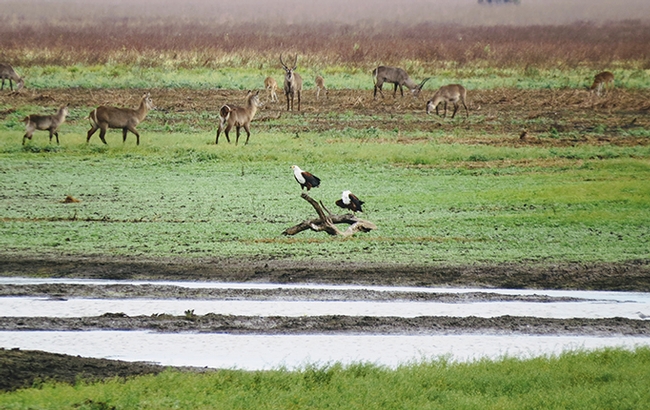Posts Tagged: biodiversity
Bringing back California’s native frogs
When Al Murphy first took the reins at the UC Hopland Research and Extension Center (HREC) back in the 1950s, he had the joy of listening to California red-legged frogs living in a couple of perennial ponds. Maybe it was the frog chorus or just the rarity of year-round water that made Al and his staff decide to keep the sheep out and declare the ponds a biological area. Despite the designation as a biological area, the ponds have lost a good deal of biodiversity since Al's time.
The native frogs took a beating thanks to bullfrogs and exotic fish such as large-mouth bass that were introduced for sport fishing and by the time Kevin Lunde did his Ph.D. on chorus frogs at HREC in 2011, there were no native frogs to be found in the ponds. Also, by removing grazing and the use of fire to manage the rangelands surrounding the ponds, tule reeds dominate the pond's edge and invasive plants such as vetch spread across the higher ground.
The recent periods of drought are devastating for most of California's ecosystems, but were good news for the ponds. They went completely dry for the first time in recorded history, and the largemouth bass died off. The long, dry period also puts us at an advantage for bullfrog eradication while the habitat for the species is limited. As part of the restoration efforts, HREC staff removed some of the bullrush and community volunteers along with members from the California Conservation Corps spent the day translocating spike rush plants from nearby locations to the recently cleared areas along the edge of the pond to provide additional warm, shallow sunning areas for native amphibians.
Only time will tell if the spike rush takes hold and, in the meantime, we hope volunteers will return to help get rid of some bullfrogs. If we can keep the bass out and the bullfrogs under control, we can look forward to a time when red-legged frogs can safely return to HREC.
Thanks, HREC staff and GrizzlyCorps member Mona Latil-Quinn, for your help.
Once perceived as a problem, conservation grazing by cattle a boon to vernal pools
Giving 1,200-pound cows access to one of California's most fragile and biologically rich ecosystems seems a strange way to protect its threatened and endangered species.
But a recently published study suggests that reintroducing low to moderate levels of cattle grazing around vernal pools – under certain conditions – leads to a greater number and greater variety of native plants.
Ecologists consider vernal pools – ephemeral ponds that form seasonally – “islands of native habitat” amid California's grasslands that are dominated by exotic grasses. These biodiversity hotspots harbor about 200 native species of animals and plants, such as the coyote thistle, which germinates under water and forms a snorkel-like straw to deliver oxygen to its roots – and then “fills in” its stem as the pool dries.
Specially adapted to survive in those stages of wet and dry, many of these species are found only in vernal pools scattered across California – making those pools an urgent priority for conservationists.
During the 1970s and 1980s, vernal pools were fenced off in parts of the state, in the hopes of protecting the flora and fauna from grazing cattle. In the early 2000s, however, UC Davis researcher Jaymee Marty found that grazing was actually crucial to vernal pool biodiversity: once livestock were removed from areas that had been grazed historically, the diversity of plants plummeted.
“Her research was critical to rethinking the best ways to protect the diversity in California's vernal pool ecosystems,” Eviner said.
The Michaels-led study, published in the Journal of Applied Biology, builds on Marty's work, by looking at scenarios where cattle had been blocked from vernal pools for decades, and then observes the rate at which biodiversity returns after reintroduction of the animals. Michaels said she wanted to provide some initial answers to the practical questions that ranchers and land managers have in potentially reintroducing cattle.
“A lot of them had these areas that had been fenced off from grazing for the last 20–30 years, and they were very concerned about what happens if we let cattle back onto these vernal pool grasslands – are there going to be negative impacts because that land had been at rest for a few decades?” Michaels explained.
They discovered that, after reintroducing cattle to areas that had been fenced off since the 1970s, there was a greater abundance of native flora (species like the vernal pool buttercup, bractless hedge-hyssop and bristled downingia), as well as increased diversity among the plants (both in number of species and in how evenly distributed they were).
“Encouragingly, diversity is rapidly restored,” Eviner said, “providing conservationists with strong data to show that rapid action can enhance plant diversity.”
And as for potential worries about cattle making a snack of vernal pool plants, Michaels and her colleagues observed that the cattle appear to be more interested in munching on grasses.
“Anecdotally, we saw very few signs of herbivory on the vernal pool species because the timing is such that [the plants] are underwater for a good part of the late winter and early spring, and then by the time they're blooming, there's plenty of good forage around for the cattle,” Michaels said.
In fact, the cattle seem to be performing a function filled for millennia by native grazers (namely, the once-abundant tule elk), helping to knock down vernal pool species' chief competitor in those transition zones: the grasses.
Instead, microdepressions created by the cattle appeared to encourage the proliferation of native plants. Each hoofprint became a miniature basin – “a vernal pool within a vernal pool.”
“Right in those transition zones, where they could be hosting either the vernal pool species or the upland grasses, just a couple centimeters of soil topography can make a big difference,” Michaels explained. “If a cow comes and steps in that transition zone, and that lowers the soil surface so it stays inundated a little longer, you end up seeing these pockets of vernal pool species that are able to persist.”
Michaels is currently conducting a follow-up study on the hoofprints to pinpoint their role in boosting native plant abundance and biodiversity. Because the prints can last for several years, they might be able to deliver some enduring benefits – and land managers might not have to bring cattle in to graze the pools as often.
“If it's really the hoofprints making the big difference, maybe we don't need to graze every year – only during certain times of year when we know the hoofprints will form well and harden, and then we're good for a few years,” Michaels said.
Protected areas needed across climates to safeguard biodiversity
Around the world, countries have established protected areas as the primary defense to reduce widespread biodiversity loss and guard vulnerable habitats. However, species and ecosystems are adapted to particular climates—as those climates shift across and outside of protected area boundaries, species may track them into unprotected landscapes where human land uses degrade conservation potential.
In a new study published in Science Advances today, Berkeley researchers offer a broad analysis of how protected areas will continue to capture the climates suitable for species into the future. The study was led by Paul Elsen, a climate adaptation scientist at the Wildlife Conservation Society and former postdoctoral researcher in the Department of Environmental Science, Policy and Management, and it was co-authored with Cooperative Extension specialist Adina Merenlender, recent Ph.D. graduate Eric Dougherty, and Bill Monahan, currently with the U.S. Forest Service.
The authors first determined how climate is expected to change within all terrestrial protected areas globally by utilizing data from several major global climate models and maps of protected areas. They found that over the next 50 to 80 years, the total amount of protected land situated in both warm and cold climates, over a wide range of annual precipitations, is expected to decline significantly.
“We calculate that most countries will fail to protect over 90% of their available climate at current levels, forcing many species to shift into unprotected lands,” says Merenlender.
Species or ecosystems adapted to specific climatic conditions would disproportionately be impacted, such as those in tropical and subtropical moist broadleaf forests, boreal forests, tundra, savannas, grasslands and shrublands.
The authors then tested how different mitigation and adaptation strategies might work to limit the amount of change species may experience in protected areas within countries, thereby reducing species' vulnerability. For example, they investigated whether greenhouse gas mitigation or the addition of new protected areas were more effective for building resilience to climate change.
“Protected areas are invaluable to conserving biodiversity, but where those protected areas are positioned in relation to available climates can have a huge influence on their ability to reduce species' vulnerability to climate change,” says Elsen.
If countries were to expand protected areas to double the diversity of climates under protection, the authors find, they would retain 118% more land area of today's protected climates into the future. By contrast, reducing greenhouse gas emissions in accordance with global targets would increase retention of currently protected climates by 102%.
“If we adopt a strategy for increasing protection that seeks to maximize the diversity of climate types represented within protected areas—for example, cold, warm, hot, wet, temperate, arid, etc.—we stand a much better chance that protected areas will continue to encompass the climatic conditions that support currently protected biodiversity,” says Elsen, lead author of the study.
The authors were surprised to find that simply establishing more protected areas wasn't the solution to building resilience. “Whether it's ‘half-earth' or a more modest target, we need more protected areas but they must be climate smart,” says Merenlender. “This means protecting a full range of climate types, or parks will not protect biodiversity as intended into the future.”
The long-term conservation potential of protected areas depends on careful maintenance of appropriate biotic and abiotic conditions that promote biodiversity. The authors stress that decisions about land use, which are socio-economic in nature, need to also account for conservation and ecosystem health. “Species that track climate into unprotected landscapes may face landscapes that are highly modified by agriculture, infrastructure, development, and other human activities, so it is still critical that we work to increase the suitability of unprotected lands for biodiversity, too,” says Elsen.
The study includes recommendations for planning for future reserves that stand to better protect biodiversity and will be more resilient to climate change over the long term.
Read the study on the Science Advances website.
Giving thanks for California’s rich natural history
From the 13,400 monarch butterflies currently overwintering in Pacific Grove’s Monterey pine trees, to the salmon migrating upstream from the ocean to their natal river in our watersheds, to the western fence lizard doing pushups on your concrete curb, we are always surrounded by nature in this state. California is one of the most biologically diverse places on Earth, providing a home for over 30,000 species of insects, 63 freshwater fish, 46 amphibians, 96 reptiles, 563 birds, 190 mammals and more than 8,000 plants!
E.O. Wilson, conservation biologist, sociobiologist, and the world’s leading authority on ants says that “Nature holds the key to our aesthetic, intellectual, cognitive and even spiritual satisfaction.” My hope for Green Blog readers this Thanksgiving week is that you can find some time to spend a few uninhibited, unstructured minutes in nature. Let your gratitude brim for whatever curiosities and satisfactions its discoveries may fulfill in you!
California Naturalist Program grows a new constituency for nature
Have you heard of the UC ANR California Naturalist Program? This new UC ANR program fosters a diverse community of naturalists and promotes stewardship of California's natural resources through education and service. Designed to introduce Californians to the wonders of our unique ecology and engage volunteers in stewardship and study of California’s natural communities, California Naturalist provides hands-on instruction and exposure to real world environmental projects designed to inspire adults to become active citizen scientists and enhance their personal connection with the natural world.
The California Naturalist Program encourages Californians to help protect and preserve our unique and diverse wildlife, habitats, rivers, lakes and coastal resources, wild and urban alike. Currently, the program certifies naturalists through 10 partnering institutions statewide, and continuing education units/college credit are available. Becoming a California Naturalist is a commitment to life-long learning. Advanced training opportunities for naturalists are continually offered by California Naturalist partners and the University of California. The program is in the planning stages for a first bi-annual statewide conference in 2014.
California Naturalist’s newest course offerings include two summer 2013 in-residency intensive courses at Nevada County’s UC Berkeley Sagehen Creek Field Station (July 8 - 14, 2013) and Sonoma County’s Occidental Arts & Ecology Center (August 15 - 22, 2013). These residential summer courses provide a chance to immerse yourself in the wonders of California’s unique ecology. Through a combination of science curriculum, guest lecturers, field trips and project based learning, participants will advance their ability to observe and understand nature. Great for teachers, docents, environmental professionals, and everyone interested in natural history.
Please learn more about taking a class or becoming a partnering institution on the website, find us on Facebook or contact us directly at canaturalist@ucanr.edu or (707) 744-1424 Ext. 104.

California Naturalists in-training participate in NestWatch, a nationwide monitoring program designed to track status and trends in the reproductive biology of birds.

